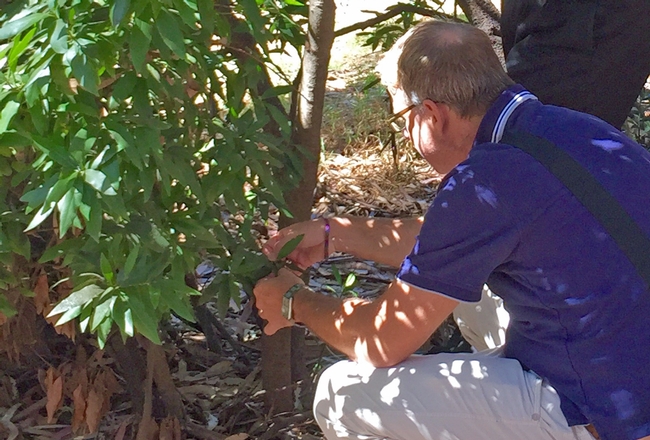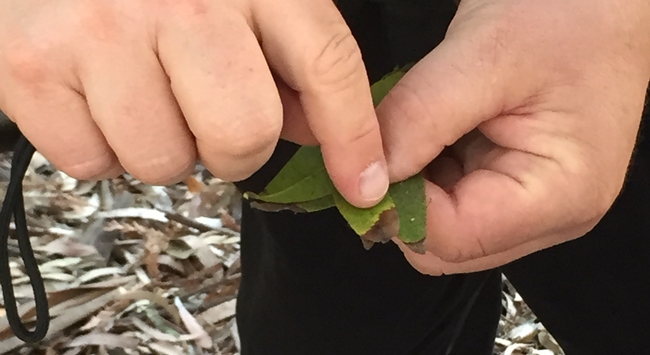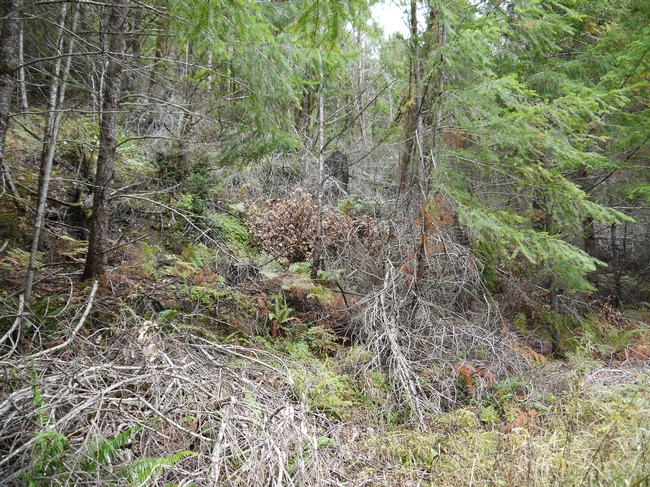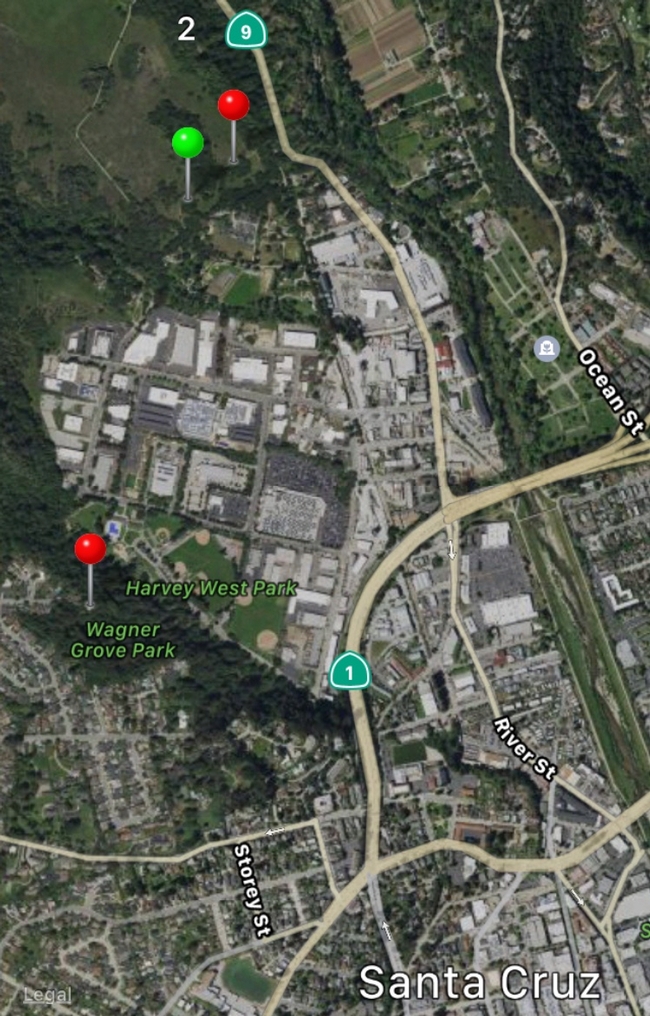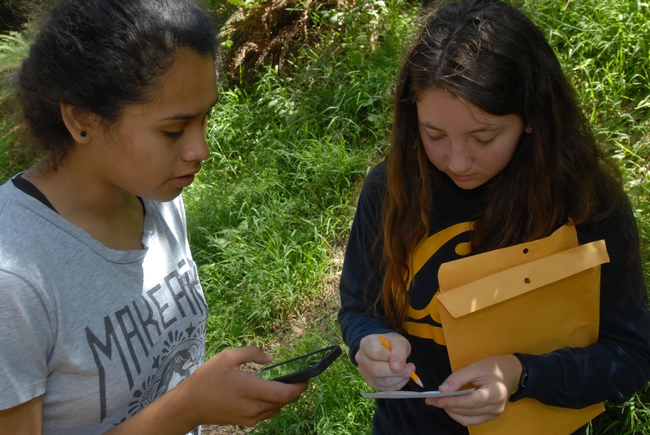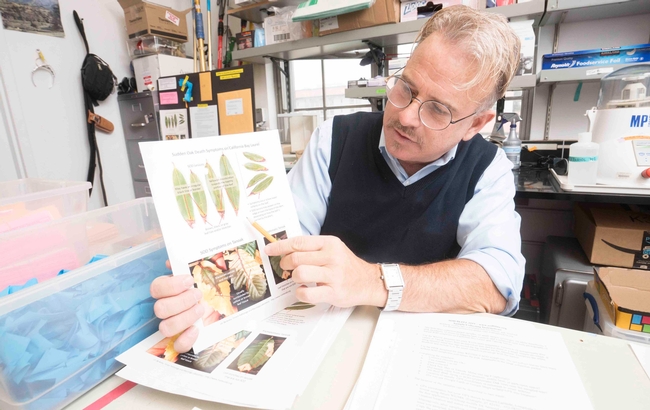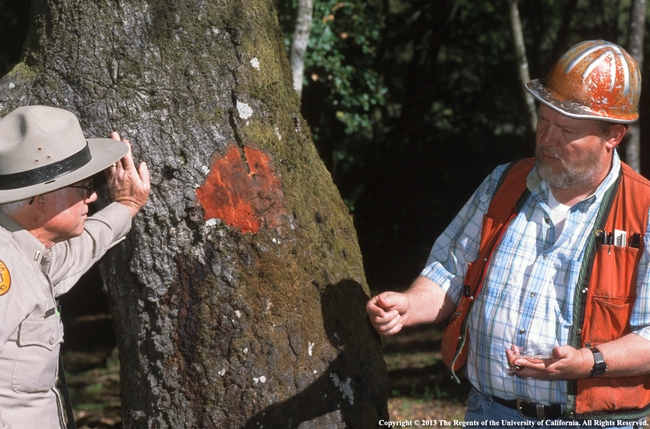Posts Tagged: sudden oak death
Citizen science SOD Blitz starts April 11 with new COVID-19 safety measures
With Californians sheltering in place to stop the spread of new coronavirus COVID-19, the annual citizen science project to map sudden oak death disease has been redesigned to ensure the safety of participants. The first in a series of SOD blitzes of 2020 will be April 11 in Napa. The events are free.
“We have been able to redesign the 2020 SOD Blitzes to make them a safe and legal activity that allows volunteers to exercise outdoors, and this powerful citizen science program will help us protect our forests' health,” said Matteo Garbelotto, UC Cooperative Extension forest pathology specialist and adjunct professor in the Department of Environmental Science, Policy and Management at UC Berkeley and event organizer.
Sudden oak death disease has killed more than 50 million of the state's iconic oaks and tanoak trees between Humboldt County and Monterey County, threatening survival of several tree species. In 2019 alone, 1 million tanoaks succumbed to sudden oak death, according to 2019 tree mortality data released by the U.S. Forest Service.
“The presence of new SOD strains is alarming and the SOD blitzes are the best, if not the only, program to intercept them before they spread,” Garbelotto said.
SOD Blitz volunteers will register online and take the training online at www.sodblitz.org to learn how to identify SOD symptoms and to carefully collect symptomatic leaves from California bay laurels and tanoaks. Collection and survey materials, which have been prepared in a sterile environment, will be picked up by participants at a local SOD Blitz station conveniently located near a parking lot. They can return samples to the same SOD Blitz station or by mail.
As citizen scientists, volunteers should focus on following safety guidance as well as adhering to research protocols. Social distancing – at least 6 feet away from other volunteers – and clean “housekeeping” rules will be strongly enforced when picking up or returning materials and during leaf collection.
For parents who are home schooling their children, this is an activity that the family can do together.
Garbelotto encourages tree care specialists to participate in the SOD blitzes.
“Besides offering free bay laurel and tanoak tests for their clients, we now offer tree care professionals free enrollment in UC Berkeley Forest Pathology Laboratory's OakSTePprogram, which allows them to test oaks for SOD infection,” Garbelotto said.
For more information, visit www.treefaqs.org or email the organizer of the SOD Blitz in your community (See schedule below).
Sudden Oak Death Blitzes 2020
All collection materials will be provided, but participants need a mobile phone or GPS device to install the free SODmap mobile app.
New format due to COVID-19
1. Training (30 minutes) and sign-up (5 minutes) must be done online at www.sodblitz.org before collecting the sampling materials at the SOD Blitz Stations in the locations specified below. Please sign up before you start the survey, and preferably when you take the online training.
2. Once at your local SOD Blitz Station you can pick up one or two collection packets following the social distancing rules of the State of California clearly specified in the online training. Stay at least 6 feet from other collectors. Bring your own pencil. Each packet allows you to sample 10 trees. Do not pick more unless you discussed it with the organizer.
3. Before you start the survey, make sure you have downloaded the free App “SODmap mobile” to determine the exact location of the trees you sample.
4. Each SOD Blitz has a start and end date, including the hour. You can pick up materials at the start time and you have to return your samples and any unused collection materials by the end date and cutoff time.
5. You can sample private properties with the owner's permission, alongside public roads and in parks or open spaces that are open to the public.
6. If you have any questions, please email your local organizer. Thank you so much for your participation.
Napa Blitz
Saturday, April 11 at 10 a.m. to Tuesday, April 14, 10 a.m.
SOD Blitz Station located on front porch of the Napa County Agriculture Commissioners Office Building 1710 Soscol, Napa
Please mail samples to UC Berkeley using the preprinted mail labels and postage included in each packet.
Contact: Bill Pramuk info@billpramuk.com
For a schedule of SOD Blitzes at other locations, visit https://nature.berkeley.edu/matteolab/?page_id=5095.
Volunteers needed to stop SOD from killing oak trees
“Two new dangerous SOD strains are at the doors of our forests,” said Matteo Garbelotto, UC Cooperative Extension forest pathology specialist in the Department of Environmental Science, Policy and Management at UC Berkeley. To assess the movement of SOD, he has mobilized citizen scientists for what he calls “SOD blitzes.” The first in a series of SOD blitzes of 2020 will be April 11 in Napa.
“We had some great results last year and participation continued to be good after 13 years of SOD blitzes,” Garbelotto said.
In Sonoma County, the 2019 SOD infection rate doubled that of 2018, and in Napa County, SOD detection was four times higher than the previous year. In the East Bay, between Richmond and San Leandro, SOD infection spiked – from 1% to 12%. The SOD infection rate tripled – from 6% to 18% on the western slopes of the Santa Cruz Mountains in San Mateo County.
As the disease expands its path of forest destruction, the UC Cooperative Extension scientist says more volunteers are needed to sample trees.
“The disease is moving to new counties outside of the current area of infestation,” Garbelotto said. “Even in our Bay Area neighborhoods, SOD of 2019 is not the same SOD of 10 years ago: different distribution, new local outbreaks, and new hosts are emerging, as the disease becomes more and more established in its new home.”
Garbelotto sees the SOD blitzes as the only hope for early detection of the new SOD strains.
“If these new strains arrived and spread in our forests, they could deliver a fatal blow to our forests,” he said. “By collecting symptomatic plant material in their neighborhoods, volunteers will make the most significant contribution possible to intercept these strains.”
Volunteers are taught to identify SOD symptoms and to carefully collect symptomatic leaves from California bay laurels and tanoaks. Participants in the SOD blitzes will be asked to quantify their efforts to stop SOD to show public interest in saving oaks and tanoaks when applying for funds to defeat the tree-killing disease.
Garbelotto is encouraging tree care specialists to participate in the SOD blitzes.
“We have enhanced the benefits for tree care professionals who participate in the blitzes,” Garbelotto said. “Besides offering free bay laurel and tanoak tests for their clients, we now offer them free enrollment in UC Berkeley Forest Pathology Laboratory's OakSTeP program, which allows tree care professionals to test oaks for SOD infection. It could be enormously beneficial to everybody.”
For more information about the SOD blitzes, visit http://ucanr.edu/sodblitz2020faq or www.sodblitz.org. See the 2020 SOD Blitz schedule at http://ucanr.edu/sodblitz2020.
ANR in the news November 1-15
Are Blackouts Here to Stay? A Look into the Future
(E&E News) Anne C. Mulkern, Nov. 15
…Throughout the United States, between roughly 2000 and 2010, about 75% of homes that burned in wildfires were located in the WUI, said Van Butsic, a land use specialist at the University of California, Berkeley. The rest was mostly in rural areas, with about 2% in cities.
People go back after they lose homes, Butsic said. He surveyed the 28 largest fires in California from about 1975 to 2005, and through aerial photos tracked what was rebuilt. About 90% of destroyed homes were rebuilt within a decade, he found. New homes also filled in large tracts of undeveloped land in formerly burned areas.
https://www.scientificamerican.com/article/are-blackouts-here-to-stay-a-look-into-the-future/
Climate Considerations for Processing Tomatoes
(AgNet West) Nov. 15
Research models show that increases in overall temperatures in California will have a direct effect on how some crops are going to be produced in the future. In one study looking at processing tomato production in the Central Valley, researchers found that changing temperatures will likely have a noticeable impact on the timing of the growing season.
“We looked at the data all the way starting from 1950, into the future by 2030-2040 and see how the time of maturity is changing,” said Tapan Pathak, UC Specialist in Climate Adaptation in Agriculture. “What we saw is, in general the time from emergence to maturity, the timeframe for processing tomatoes in that region, is going to shrink down almost by two to three weeks.”
http://agnetwest.com/climate-considerations-processing-tomatoes
What's Growing On: American rose trials test sustainability
(Stockton Record) Marcy Sousa, Nov. 15
Did you know San Joaquin County Master Gardeners have been part of a National Rose Trial since 2018? The trial is part of the American Rose Trials for Sustainability (A.R.T.S.) program that has trial sites across the United States. It was initiated in 2012 by individuals representing multiple rose stakeholder groups, including: industry, the scientific community and public gardens. There are only two Mediterranean climate trial locations and both are in California. The trials at the Fullerton Arboretum started in 2019 and the UC Cooperative Extension office in San Joaquin County began in 2018.
…Our Environmental Horticulture Advisor, Karrie Reid, has been managing and overseeing the trial since 2018. Our roses were planted in unused turf areas that were converted to the trial grounds. One of the selling features of converting the turf sections was the calculated water savings: 3,656 square feet of turf used 103,000 gallons of water, while 60 roses in the same area on drip use 6,175 gallons, a 94 percent savings. Trial sites are covered with a 3-inch layer of wood mulch.
Report: California ag is a major economic driver for the state
(Agri-Pulse West) Brad Hooker, Nov. 13
A new report by the University of California Division of Agriculture and Natural Resources (ANR) adds new dimensions to the “massive economic juggernaut” of the California agricultural industry. The findings reveal that agriculture contributed more than $263 billion to the economy in 2018 through direct sales and employed more than 1.2 million people, while benefiting urban and rural regions alike.
The report examines the entire “working landscape,” which also includes fishing, forestry, mining, outdoor recreation and renewable energy, in addition to agricultural distribution, production, processing and support. Together, the sectors represent $333 billion in sales, 1.5 million jobs and 6.4% of the total California economy, outranking the healthcare, real estate, construction and retail sectors. Agriculture accounted for 85% of the working landscape businesses and 79% of the sales income. According to ANR Vice President Glenda Humiston, the working landscape likely surpasses the finance sector as well.
UCCE Addressing Watergrass Issues in California Rice Fields
(AgNet West) Brian German, Nov. 13
Researchers from UC Cooperative Extension (UCCE) are looking closely at the watergrass issues in California rice fields to get a better understanding of the problem. Watergrass has historically been a fairly common weed species that growers face, however in recent years the issue has been compounded by a number of factors. Several watergrass species have demonstrated resistance to the materials available and it appears that one or two new species may have emerged.
“In the past few years watergrass is becoming more and more of a problem, whether it's the ones that we know that we have or these possible new species,” said Whitney Brim-DeForest, UC Rice Farm Advisor serving Sutter, Yuba, Placer, and Sacramento Counties. “It's just becoming more difficult to control with the herbicides that we have.”
http://agnetwest.com/ucce-watergrass-issues-california-rice-fields/
Experts Warn Of Surge In Sudden Oak Death Infections In North Bay
(KPIX) Wilson Walker, Nov. 12
“And then, of course, these limbs that have just fallen off,” said Kerry Wininger of UC Cooperative Extension as he stood beneath a dying tree in Sonoma County's Fairfield Osborn Preserve. “And big patches will come out at once.”
Wininger is with the UC team working to measure the problem, and the numbers are up dramatically. She oversees a yearly survey conducted by volunteer citizen scientists.
…“For Sonoma County in general, Sudden Oak Death numbers look about double where they were last year,” said Wininger. “So it's actually increasing at a rate a little bit faster than we would expect.”
Shelter exercise at the fairgrounds
(Appeal Democrat) Ruby Larson, Nov. 12
Some Glenn County agencies came together at the Glenn County Fairgrounds to participate in a shelter management training exercise last week.
…Travis said agencies that participated included Health and Human Services, sheriff's office, animal control, UC Cooperative Extension and North Valley Animal Disaster Group.
California's Wildfire Policy Totally Backfired. Native Communities Know How to Fix It.
(Mother Jones) Delilah Friedler, Nov. 11
…“We aren't anywhere near bringing fire back at the scale we need to,” says Lenya Quinn-Davidson, a fire advisor with the University of California Cooperative Extension who helped lead that burn. “It's important to push forward with a grassroots model that empowers people to do the work, instead of having bottlenecks with the agency that's in charge.”
The Humboldt County Prescribed Burn Association, which Quinn-Davidson leads, was the first organization of its kind in the West when it started in 2018, and has already inspired similar groups to start up in northern California's Plumas, Nevada, Sonoma, and Mendocino counties. These groups bring landowners and neighbors together to provide the manpower that controlled burns require. Quinn-Davidson says she's hosted 25 lecture and field-based workshops in the past year to increase people's comfort with prescribed fire, and in the past two years, she's led 20 burns on private lands.
Zediker honored as CattleWoman of the year
(Siskiyou Daily News) Nov. 10
Siskiyou County native Jacki Zediker was honored on Saturday, Oct. 26 as the 2019 Siskiyou County CattleWoman of the Year during the annual Cattlemen and CattleWomen's dinner in Yreka.
… Zediker has been the 4-H Youth Development Program Representative with the UC Cooperative Extension in Siskiyou County for more than 20 years, and has served as the regional coordinator for the North State counties in recent years, the CattleWomen said.
- https://www.siskiyoudaily.com/news/20191110/zediker-honored-as-cattlewoman-of-year
- https://www.taftmidwaydriller.com/news/20191110/zediker-honored-as-cattlewoman-of-year
Insect entrepreneurs use almond hulls as feed source for bugs
(Daily Democrat) Ching Lee, Nov. 8
…Maurice Pitesky, a UC Cooperative Extension veterinarian and specialist in poultry health and food-safety epidemiology, conducted an experiment two years ago on pastured layers, feeding up to 20% of the birds' diet with soldier fly larvae “with no change in welfare, egg quality, mortality.” The larvae feed provides methionine, an essential amino acid for poultry, and has “significant potential” to increase poultry production while freeing “more corn and soy calories for humans,” he said, though he warned of two caveats: economics and consistency of manufacturing the feed.
http://www.dailydemocrat.com/insect-entrepreneurs-use-almond-hulls-as-feed-source-for-bugs
Paradise rebuilds, but fire safety sometimes takes a back seat to economic realities
(LA Times) Laura Newberry, Nov. 8
…“Having this zone right next to a building is pretty important,” said Steve Quarles, a senior scientist with the Institute for Business & Home Safety who studied homes in Paradise after the fire. “No matter what the homeowner does in terms of vegetation management on the property, embers can blow over and ignite that woodpile next to the house.”
For the Record (LA Times) Nov. 12
Camp fire: In the Nov. 8 Section A, an article looking at the changes in Paradise, Calif., since the Camp fire a year earlier misidentified Steve Quarles as a senior scientist with the Institute for Business & Home Safety. Quarles has retired from that post and now serves as a UC Cooperative Extension advisor emeritus.
https://www.latimes.com/california/story/2019-11-08/rebuilding-paradise-one-year-after-camp-fire
Sudden oak death rebounds in Sonoma County, spreads in California
(Press Democrat) Guy Kovner, Nov. 8
… Matteo Garbelotto, director of the forest pathology and mycology laboratory at UC Berkeley, said discovery of the two infected tanoaks in Del Norte County was a signature finding of this year's sudden oak death survey, known as the SOD Blitz, organized by his lab since 2008.
“It's a good thing that we detected it because the sooner we know, the more options available to minimize the impact of the disease,” he said.
https://www.pressdemocrat.com/news/10262894-181/sudden-oak-death-rebounds-in
The 2050 challenge
(Iowa Farm Bureau) Teresa Bjork, Nov. 8
…Dr. Frank Mitloehner, an air quality extension specialist at the University of California-Davis, said American consumers don't realize that modern agriculture practices have helped increase our food supply while decreasing potential greenhouse gas emissions.
“It's time for us to explain what we do in agriculture in a way that the public understands,” Mitloehner said.
https://www.iowafarmbureau.com/Article/The-2050-challenge
Sudden oak death spreading fast, California's coastal forests facing devastation
(San Francisco Chronicle) Peter Fimrite, Nov. 7
…The rate of trees infected almost doubled in 2019 — from 3.5% to 5.9% — and was 10 times higher in some places compared with the 2018 survey, said Matteo Garbelotto, the director of the UC Berkeley Forest Pathology and Mycology Laboratory, which tested leaf samples taken by 422 volunteers.
...“There was a significant increase in infection rates over last year, but that's not totally surprising because we had a lot more rainfall,” Garbelotto said. “But it was a surprise to see them all at once. It's telling us we are entering a different phase of the disease, where the organism isn't really establishing itself in new areas, but is showing itself more when weather conditions are favorable.”
We mapped every wine country fire. They're larger and more destructive than ever
(Los Angeles Times) Priya Krishnakumar, Nov. 7
…Why is this happening? Scientists point to rising temperatures and the effects of Santa Ana and Diablo winds on increasingly dry terrain.
“In a way, climate change is priming the landscape to ignitions,” said Max Moritz, a wildfire specialist at UC Santa Barbara.
…Experts say many of the losses are due to increased development, as more and more homes have been built in areas prone to fire.
“The homes are the fuels,” Moritz said. “We see these burned neighborhoods where there are still shrubs and trees, and it's clear the homes propogated the fire.”
https://www.latimes.com/projects/wine-country-fires-california-sonoma-napa/
Water users making case in bankruptcy court; Cal Fire says dry canal poses fire hazards
(Chico News & Review) Ashiah Scharaga, Nov. 7
…Gosselin said the county is scheduling another meeting with water users for January. While “we cannot get in the middle and restore water to the Middle Miocene,” he said, it is exploring a project with Del Oro to extend water service on Pentz Road, which would help some of the folks who have been served by the canal. The UC Cooperative Extension is also close to completing an economic study related to the loss of the Miocene on water users, and Gosselin intends to seek grants and other funding for water supply reliability projects.
https://www.newsreview.com/chico/missing-in-action/content?oid=29213484
Farm City Newsday Thursday, 11-07-19
(AgNet West) Danielle Leal
Get the latest agriculture news in today's Farm City Newsday, hosted by Danielle Leal. Today's show is filled with stories covering the current disconnect in state and federal hemp regulations, California's working landscape sector providing significant economic value and details on the Almond Board of California's conference silent auction that benefits FFA students and how you can help. Tune in to the show for these news stories, recipes, features and more.
http://agnetwest.com/farm-city-newsday-thursday-11-07-19/
California working landscapes generate $333 billion in sales and 1.5 million jobs
(News release) Pam Kan-Rice
- https://plantingseedsblog.cdfa.ca.gov/wordpress/?p=19581
- https://yubanet.com/california/californias-working-landscape-generates-333-billion-in-sales-1-5-million-jobs
- https://cvbtcom.ipower.com/californias-working-landscape-generates-333-billion-in-sales/
- https://fruitgrowersnews.com/news/study-californias-working-landscape-supports-more-than-1-5-million-jobs/
Power shutoffs leave some farmers feeling ‘helpless'
(Ag Alert) Ching Lee, Nov. 6
… "If they've lost cooler capacity or the ability to wash product, not only are they taking a hit on the expense side, but they have less to sell," Placer County sheep rancher Dan Macon said. "That's kind of a double whammy for a number of folks."
… Wineries also are running into this problem, said Anita Oberholster, an enology specialist for University of California Cooperative Extension. Those operating on generators are running low on fuel and can't get it to their wineries, which need power not only to process fruit but to control temperature during the fermentation process. Because yeast can generate a significant amount of heat during fermentation, an inability to control temperature could affect the quality of the wine, she said.
… "People are making the investments they need to make, but it's stuff that's outside the normal course of business, and I think there'll be some financial impacts from that in terms of this season's profitability," he said.
As a UCCE livestock and natural resources advisor, Macon said the outage has prompted him to start sending a survey to farmers in an effort "to catalog resources that are out there and available for sharing in situations like this," whether it's generators, water-hauling capacity or, in the case of fire, the ability to load livestock quickly and safely.
http://www.agalert.com/story/?id=13411
Spring rains likely caused waterlogging of walnut trees
(Farm Press) Logan Hawkes, Nov. 6
…Luke Milliron, UCCE Farm Advisor in Butte, Glenn, and Tehama Counties and Janine Hasey, UCCE Farm Advisor Emeritus, also addressed the topic in a recent blog post.
“Plant roots need to breathe,” they wrote. “This process of respiration is critical to energy production in roots. Saturated surface soil moisture levels restrict root access to atmospheric oxygen, limiting the energy production of respiration and eventually resulting in root asphyxiation (death).”
https://www.farmprogress.com/tree-nuts/spring-rains-likely-caused-waterlogging-walnut-trees
California agriculture in 2050 – where we are headed and why
(CDFA blog) Nov. 5
At its monthly meeting today, the California State Board of Food and Agriculture heard a cautiously optimistic appraisal of agriculture's future through 2050 from economist Dr. Daniel Sumner, director of the Agricultural Issues Center at UC Davis. Dr. Sumner believes that net farm income will continue to grow, even though it may experience ups and downs, and that growth specifics will hinge on the management of five key cost factors:
https://plantingseedsblog.cdfa.ca.gov/wordpress/?p=19531
Beckstoffer Vineyards, in Partnership with University of California, Davis and Duarte Nursery, Launches Groundbreaking Clonal and Rootstock Trial Addressing Climate Change and Improved Grape Quality in Cabernet Sauvignon
(Wine Industry Advisor) Nov. 5
Andy Beckstoffer, perhaps the most recognized California grower of wine grapes, announced that Beckstoffer Vineyards, in partnership with University of California, Davis and Duarte Nursery, has launched a groundbreaking trial addressing climate change and improved grape quality for Cabernet Sauvignon at Beckstoffer's Amber Knolls Vineyard in the Red Hills of Lake County. University of California, Davis called the trial “the mother of Cabernet research trials.”
Study: California's working landscape supports more than 1.5 million jobs
(Fruit Grower News) Nov. 5
California's working landscape and the industries associated with agriculture and natural resources contribute significantly to the state's economy, according to a new study by the California Community Colleges Centers of Excellence for Labor Market Research, California Economic Summit and the University of California's Division of Agriculture and Natural Resources.
UC scientists seek innovative uses of ag waste
(Farm Press) Chris Brunner, Nov. 5
…Historically these waste materials have been used as a rich source of compost. However, scientists at UC Cooperative Extension are researching innovative uses for this material.
Dr. Pramod Pandey, a faculty member and Cooperative Extension specialist at the UC Davis School of Veterinary Medicine, focuses on better ways to manage waste material for both large and small farms. Dr. Pandey researches how to convert the organic matter in manure and other waste materials into a renewable energy source that can be used to power our state.
https://www.farmprogress.com/dairy/uc-scientists-seek-innovative-uses-ag-waste
Shifting Winds in Fire Management
(Noozhawk) Harrison Tasoff, Nov. 4
…“We are mixing up the problem of forest and fuel management with the problem of wildland-urban interface fires,” said Max Moritz, an adjunct professor at UC Santa Barbara's Bren School of Environmental Management and a statewide Cooperative Extension wildfire specialist.
https://www.noozhawk.com/article/shifting_winds_in_fire_management
Early UC hemp research already yielding results
(Farm Press) Jeannette Warnert, Nov. 4
For the first time ever, UC Agriculture and Natural Resources (UC ANR) researchers harvested an industrial hemp crop at one of its nine research and extension centers this fall.
“It's an interesting crop,” said UC Cooperative Extension specialist Bob Hutmacher. “There is a tremendous amount of research that can be done to understand its growth and best cultural practices, optimal planting dates either by seed or transplants, irrigation and fertilization management, and, particularly, to address pest and disease management.”
https://www.farmprogress.com/hemp/early-uc-hemp-research-already-yielding-results
Day of the Dead – More Than a Colorful Sugar Skull, UC ANR Says
(Sierra Sun Times) Ricardo A. Vela, Nov. 2
- Many of us in the US have seen or heard something about the Mexican celebration El Dia de Los Muertos (Day of the Dead), whether it's a reference in a horror movie or a community fair where children get their faces painted as colorful skulls. For many, that is the extent of their knowledge of this millenary, radiant and vibrant Mexican celebration.
Early UC Hemp Research Already Yielding Results
(CalAg Today), Nov. 2
For the first time ever, UC Agriculture and Natural Resources (UC ANR) researchers harvested an industrial hemp crop at one of its nine research and extension centers this fall.
"It's an interesting crop," said UC Cooperative Extension specialist Bob Hutmacher. "We don't have a lot of experience in UC ANR with hemp at this time. There is a tremendous amount of research that can be done to understand its growth and best cultural practices, optimal planting dates either by seed or transplants, irrigation and fertilization management, and, particularly, to address pest and disease management."
https://californiaagtoday.com/early-uc-hemp-research-already-yielding-results/
In Woodlake, One Motivated Couple And A Mile-Long Garden Inspire Children And Flowers To Flourish
(KVPR) Alice Daniel, Nov. 1
…And that's the point, right there. It's why two life-long Woodlake residents, Olga and Manuel Jimenez started the garden 16 years. Ago. It's named for the lake next to it. Taking care of the garden builds character, Manuel says. And strong work skills, and relationships.
… It sits between a lake and a road on land the city bought with a rails to trails grant, so it's far longer than it is wide. Manuel's retired now but he designed it when he was still a UC small farm advisor.
California Fire Danger Continues to Worsen, Experts Say
(Wall St J) Jim Carlton, Nov. 1
…“There's no simple problem and no one simple answer,” said Max Moritz, statewide fire specialist based at the University of California, Santa Barbara.
https://www.wsj.com/articles/california-fire-danger-continues-to-worsen-experts-say-11572623148
On the Hunt: Study Seeks Answers on Wildlife Exposure to Lethal Rat Poison
(CSU Fullerton) Nov. 1
…Under the mentorship of Paul Stapp, professor of biological science, and in collaboration with scientist Niamh Quinn, a human-wildlife interactions advisor with the University of California Cooperative Extension in Irvine, Burke is studying how native wildlife is exposed to rodenticides. Burke has been working on the research over the past two years for his thesis project.
…For his project, Burke set up bait stations — tamper-proof black boxes — at 90 sites in Orange County — in the backyards of homeowners who participate in the Master Gardeners of Orange County program, and grow large amounts of fruits and vegetables, which attract animals, including rats.
http://news.fullerton.edu/2019fa/rat-poison-research.aspx
As fires rage, pressure mounts to train California's next generation of forest stewards
(Edsource) Sydney Johnson, Nov. 1
… Blake Schmidt, a math teacher at Ross Middle School in Marin County, decided to take his students to Forestry Challenge after participating in a free [UC ANR] statewide program for California teachers called the Forestry Institute for Teachers.
2019 SODBlitz shows Sudden Oak Death on the rise in California
Sudden Oak Death (SOD), a serious exotic tree disease, threatens the survival of tanoak and several oak species in California. Currently, SOD infects trees in 14 coastal California counties, from Monterey to Humboldt. The disease, which was estimated to have killed over 50 million oaks and tanoaks over two decades, has changed the coastal forests composition in Northern California and Southern Oregon.
Though SOD occurs in patches, the overall infection area continues to grow with each passing year. Researchers had previously discovered that Phytophthora ramorum, the pathogen that causes SOD, most often spreads on the leaves of infected California bay laurel and tanoak. Forest managers can use proactive methods for controlling the disease — including sanitation, chemical treatments, and the targeted removal of bay trees — but such tools are preemptive in nature, only useful before oaks and tanoaks are infected. Timely detection of the disease in these species is therefore critical to slowing the epidemic.
With this in mind, UC Berkeley joined with over 30 local organizers in 2019 to assemble 25 SOD Blitzes staffed by trained volunteers. More than 400 volunteers were taught to identify SOD symptoms and to carefully collect symptomatic leaves from California bay laurels and tanoaks. Armed with this training, the teams surveyed 16,227 trees across 16 California counties, collecting approximately 9,000 leaves from 1,732 symptomatic trees. Samples were sent to the UC Berkeley Forest Pathology and Mycology Laboratory for processing and analysis.
The benefits of SOD Blitzes are becoming increasingly clear. Importantly, they educate the community about Sudden Oak Death, getting locals involved in detecting the disease while creating detailed maps of infected areas. Analyses of these maps help forest managers figure out where proactive measures, such as chemical treatments or tree removal, most effectively stop an infestation. All results from the data collection are made publicly available on SODBlitz.org, SODMap.org, and on the SODmap mobile app available at the Apple Store and at Google Play. (Results can also be accessed directly on the UC Berkeley Forest Pathology and Mycology Laboratory website.)
Using the app allows anyone to estimate the risk of oak infection, specific to their current location. While standing next to a tree of interest, a person can tap the app's “RISK” button and determine whether an oak is in danger of contracting SOD. In addition, results meetings and treatment training workshops will be held for the public in various Bay Area locations during fall 2019.
Matteo Garbelotto, UC Cooperative Extension specialist and adjunct professor in the Department of Environmental Science, Policy, and Management, has led the SOD Blitzes for 12 years. The program enrolls approximately 500 volunteers yearly to canvas California woodlands for symptoms of SOD. Results of the surveys are made available nearly in real-time, immediately after completion of the lab analysis.
“We estimate that as many as two to three million people may have accessed the SOD Blitz results to determine whether trees on their property may be at risk,” Garbelotto said. “This is a huge success and shows the great societal value that citizen science has, and it highlights the importance of collaborating with volunteers on issues that are relevant to safeguard trees that are an important part of California's natural heritage.”
2019 SOD Blitz Results
Across the state, the number of trees infected with SOD, along with the estimated SOD infection rate, has almost doubled since 2018. In some areas, infection rates were as much as 10 times higher than the previous year. These results suggest that the overall risk of oak infection by SOD is rising.
Spikes in the estimated SOD infection level at certain locations are particularly noteworthy; for example, from 1 to 12 percent in the western part of the East Bay between Richmond and San Leandro, including distinct outbreaks discovered in El Cerrito, Kensington and Berkeley. The western slopes of the Santa Cruz Mountains in San Mateo County have also seen an increase in SOD infection rate (from 6 to 18 percent), which may make safeguarding recreational venues and ecologically important forest sites more difficult. In Sonoma County, the 2019 SOD infection rate was approximately double that of 2018, and in the same timeframe, Napa saw a fourfold increase in detection. Peninsula towns between Redwood City and Los Altos Hills had a very high infection rate (21.6 percent) with an expansion of outbreaks to the east and north.
Some additional key results that came from the 2019 SOD Blitzes include:
- Two tanoaks were positive for SOD in a state park east of Crescent City in Del Norte County, marking the first report of SOD for the county. This was an important finding because, until 2019, Del Norte was the only county free of the disease in the area between the vast California infestation and the Southern Oregon outbreak. The SOD Blitz finding does not have immediate implications for regulations, but regulations will be imposed once CDFA can confirm the finding.
- An extensive survey of San Luis Obispo failed to identify SOD; however, multiple trees were found to be infected in the southernmost canyon of Monterey County. Previously, this canyon had only provided positive findings from water monitored by UC Davis scientists, but not from trees.
- Although Humboldt County has a few significant SOD outbreaks, and Trinity County has a marginal SOD outbreak in its southwestern border, SOD Blitzes in tribal lands in Humboldt and Trinity counties did not yield any SOD positives.
- San Francisco parks, including the Presidio, were negative for a second year in a row, suggesting that disease management practices have been successfully implemented in the area.
- Several cases were identified in the northern neighborhoods of the City of Napa. No positives had been found in this area since 2011.
- All isolates of the pathogen belonged to the NA1 lineage, which is more easily treated and common in the region. This is good news because of uncertainty about the potential virulence of the EU1 lineage recently discovered in Oregon forests.
A sampling of other noteworthy 2019 SOD Blitzes results follow. More results are available on the websites and app:
- The first infected Bay laurel was identified a few miles east of the town of Mendocino (Mendocino County) along the Comptche-Ukiah Road.
- Multiple SOD positive trees were identified between Guerneville and Duncan Mills in Sonoma County. The Russian River area has long been known to be affected by SOD.
- An outbreak was identified in southwestern Petaluma, while infestations were confirmed in Bennett Valley, Santa Rosa and east of Rohnert Park.
- Multiple infestations were identified in Marin County, including the ones northeast of San Rafael, Larkspur, Woodacre, Mount Tamalpais, Marin City and north of Inverness.
- In the Peninsula, SOD was identified in Burlingame Hills, northern Woodside, Emerald Hills, Palomar Park, Portola Valley. In Los Altos Hills and Loyola, SOD positive trees were detected both East and West of Interstate 280. An outbreak was detected west of Saratoga.
- High levels of infection were identified all along Skyline between Bear Gulch Road and Highway 17, and on the western slopes of the Santa Cruz Mountains between Skyline and Pescadero.
- SOD was confirmed between Felton and Santa Cruz and between Aptos and Santa Cruz.
- In Monterey County, the chronic Big Sur outbreak was once again confirmed to be active, while the disease appeared also in drier areas of the Carmel Valley, where it had been absent for a few years.
The SOD Blitz program was funded in part by the U.S. Forest Service's State and Private Forestry Organization and by the Midpeninsula Regional Open Space District. It was also made possible by a collaboration with the California Native Plant Society, CalFire, the Humboldt/Del Norte and Sonoma County UC Cooperative Extension, the Sonoma County UC Master Gardeners, the U.S. National Parks, California State Parks, the East Bay Regional Parks, the San Francisco Public Utility Commission, Mid-Pen Open Space, the UC Santa Cruz Arboretum, Santa Cruz Open Space, the Santa Lucia Conservancy, the Karuk and Hoopa Nations, the Mendocino Botanical Garden, the City and County of San Francisco Parks and Recs Office, and Strybing Arboretum. Many individuals, who have generously devoted their time and efforts, have been pivotal for the existence and success of the program.
READ MORE:
- Matteo Garbelotto: Leading the citizen science contagion
- First known cases of sudden oak death detected in Del Norte County
- SOD Blitz Project
- SOD Blitz map of results and summary table
2020 may see increased number of trees suffering 'sudden oak death'
California's unseasonably rainy spring may trigger more incidences of tree mortality due to sudden oak death, reported Sonia Waraich in the Eureka Times-Standard.
That impact may not be known for a while. UC Cooperative Extension forest advisor Yana Valachovic said the spike in tree deaths typically occurs the year following the spring rains, making 2020 a year of particular concern.
“One of the issues that becomes very apparent is that when we have these peak episodes of mortality, there isn't much funding to help us manage those impacts,” Valachovic said.
UCCE research associate Brendan Tweig said land managers must be flexible in implementing strategies to prevent the spread of sudden oak death.
"The disease doesn't go where you think it's going to go and then you're always limited by what you can do at any given location," he said.
The areas where the disease is discovered are treated more heavily, Twieg said.
The treatment strategy relies primarily on thinning infected trees, which increases air flow between the remaining trees. That helps dry out the area and avoid creating the moist environment in which the disease does best.


